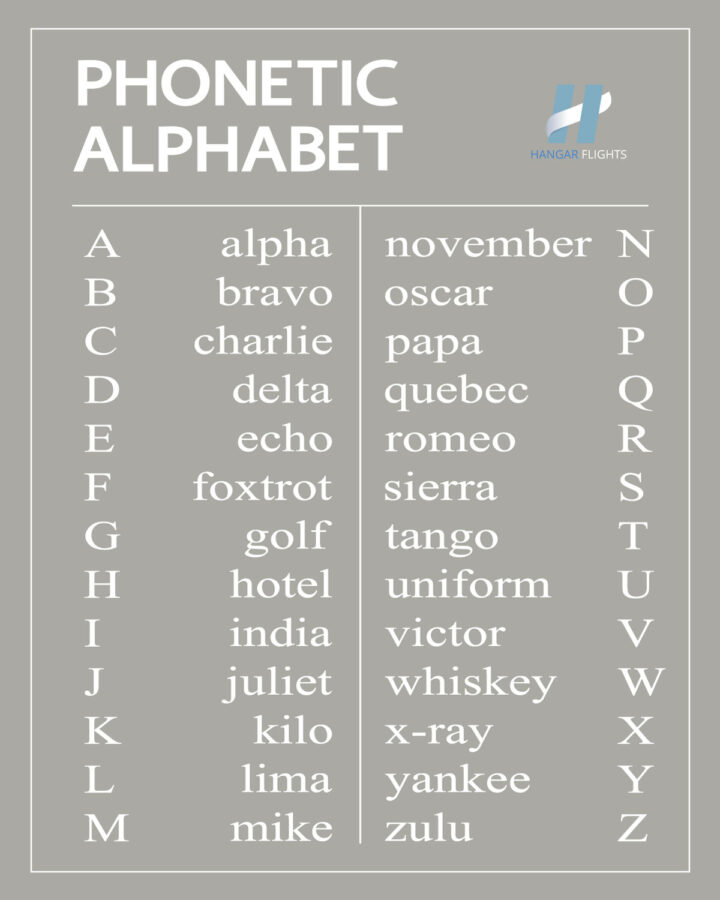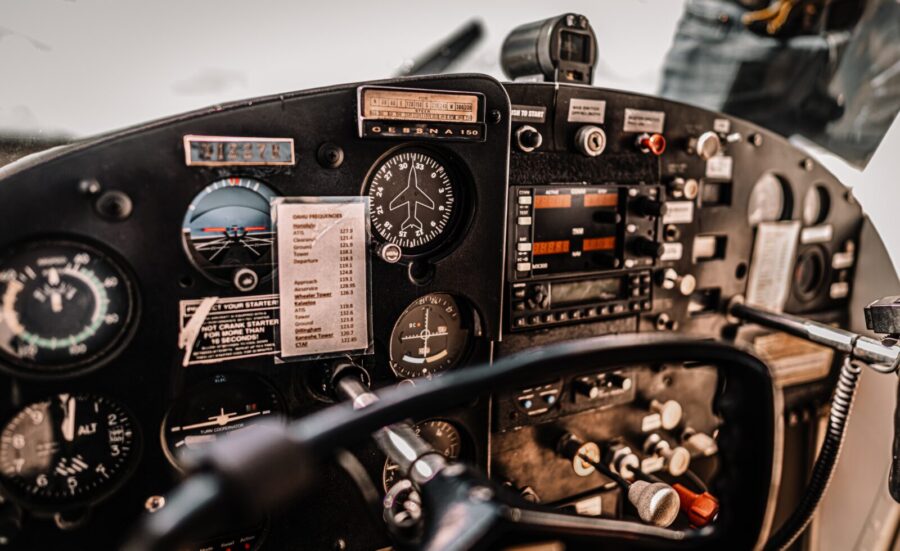The History of the NATO Phonetic Alphabet Used in Aviation
17 August 2022 | Updated on February 05, 2024
Misheard words can be frustrating. It happens when our brain fills unclear words and phrases with the mumbo-jumbo of words and phrases accumulated from our daily experiences. It can be amusing to misinterpret ‘deep seeded’ for ‘deep-seated,’ but the consequences of a pilot mishearing a landing or extraction coordinates can be fatal.
Aviation operations require error-free efficiency and communications. Experts within the industry saw the need for an aviation alphabet, a list of codes that coordinates to the letters of the standard English alphabet to prevent misunderstandings resulting from poor line communication, ambiguous or hard-to-spell words, different accents, or pronunciations.
Pilots, air traffic controllers, and ground crews use the aviation alphabet to communicate. Military organizations worldwide also use phonetic alphabets in radio communications, a popular example being the NATO alphabet.
History Of The NATO Phonetic Alphabet
The increasing popularity of shortwave radio communications led the Consultative Committee for International Radio (later renamed International Telecommunication Union ITU) to adopt the first civilian phonetic alphabet in 1927 for commercial and private radio communications in 1297. Following its successful adoption by the ITU, the International Commission for Air Navigation (later renamed International Civil Aviation Organization ICAO) decided to adopt the phonetic alphabet in 1932 with some minor changes for civil aviation use. This phonetic alphabet version remained in service with the International Maritime Organization IMO until 1965.
Different military forces had their phonetic alphabet before adopting the ICAO alphabet in 1956. For example, the British Army adopted the Royal Air force phonetic alphabet, a close version of the Royal Navy’s phonetic alphabet since World War 1. During World War 2, the United States military adopted the Joint Army/Navy radiotelephony alphabet (JAN), commonly called’ Able Baker’ after the words representing A and B, creating a universal phonetic alphabet for all branches of the U.S armed forces.
The quest for a standard international aviation alphabet became a reality after World War II when the Allied military forces adopted the ‘Able Baker’ phonetic alphabet. And in 1946, the Second Session of the ICAO Communications Division adopted “Able Baker’ for international civil aviation use. However, problems with the unique Anglophone words in the alphabet led to the development of an alternative ‘Ana Brazil’ phonetic alphabet for Latin America.

Despite the setback, the International Air Transport Association IATA continued to develop a universal aviation alphabet. Between 1946 and 1949, it put its resources into creating a draft phonetic alphabet with common English, French, Spanish, and Portuguese words. In 1951, ICAO ratified the IATA alphabet only for international civil aviation use. But it was instantly unpopular as several users believed it was “too severe” and immediately reverted to the former ‘Able Baker’ alphabet. ICAO and 31 countries, including the United States and the United Kingdom, researched to identify problem words and offer more appropriate replacements.
By January 1956, the study was complete, and the codewords for the five letters C, M, N, U, and X were replaced. The ICAO sent the new version of the Radiotelephony Spelling Alphabet to all member states on 1st March 1956 to eliminate communication discrepancies resulting from using multiple phonetic alphabet systems.
NATO adopted the official ICAO phonetic alphabet on March 1st, 1956, along with a few changes based on U.S Air Force research which included changing one word (November). The ITU, which regulates all international radio communications, adopted the NATO alphabet in 1959, paving the way for mass adoption by military, civilian, and amateur radio operators across the globe.
What Is The NATO Phonetic Alphabet?
The NATO phonetic alphabet, also known as the International Radiotelephony Spelling Alphabet or the ICAO spelling alphabet, is a set of code words that uses a list of words/names to represent and communicate letters of the Roman alphabet. It is the most widespread global system used by the military, civil aviation, emergency services, and the maritime industry to avoid communication blunders and achieve better operational efficiency.
It was adopted in response to the concerns faced when using voice-activated two-way radio in areas with inadequate coverage, or during noisy and loud conditions where it is difficult to discern letters and numbers. Creating the 26 alphabet code took place over a significant period, with NATO adopting a modified version of the ICAO phonetic alphabet in 1956. The version included words that were accessible and easily understood in English. French, Spanish, and Portuguese speakers.


How Were The Words In The NATO Phonetic Alphabet Chosen?
The process of selecting words in the NATO phonetic alphabet is meticulous. According to a 1955 NATO memo, the (spelling) alphabet was the outcome of numerous exhaustive tests performed on a scientific basis by several countries. And minor changes to clear any inconsistency between one or more letters must involve a reconsideration of the entire alphabet to ensure the proposed changes do not create a divergence altering the overall functionality of the alphabet.
According to professor Jean-Paul Vinay, a linguist with the Université de Montréal who was a key member of the ICAO research team that developed the first universal phonetic alphabet draft between 1948 to 1949. The ICAO typically considers the following before choosing a word.
These include
- It must be a live word in each of the three working languages: English, French, and Spanish.
- It must be easily pronounced and recognized by airmen of every language.
- It must have good radio transmission and readability characteristics.
- It must have a similar spelling in at least three English, French, and Spanish, with the Initial letter being the letter the word identifies.
- It must be free from any association with objectionable meanings.
How Relevant Is The NATO Phonetic Alphabet Today?
The NATO phonetic alphabet remains relevant sixty-six years after its official adoption with more countries, armed forces, industries, organizations, and individuals using it than before. The first time you heard the NATO alphabet was probably in a war movie or spy television show, and by now the word “Foxtrot” has a deeper meaning to you than just a ballroom dance.
We live in a fast-paced world where we can’t get away from the noise and distractions surrounding our lives. And communications suffer as a consequence. The NATO phonetic alphabet helps us to make sense of the clutter of information we deal with on a daily basis by indicating the exact terms of contract detail like a name, serial number, or street address.
The NATO phonetic alphabet is indispensable when giving out vital information to the police emergency services. Hospital emergency wards, typically epicenters of chaos, use it when recording or retrieving a patient’s information. Even our personal conversations are often sprinkled with snippets of the NATO phonetic alphabet, especially when giving out precise information or description over a bad phone connection or in a noisy environment.
Apart from its traditional applications in the military and aviation industry, the NATO phonetic alphabet is part of everyday life for people working in law enforcement, utility companies, the electronic media, and academics, where it is a helpful training reference for communications and language studies. It is also employed by linguists, speech therapists, and language teachers to confirm word sounds and pronunciation.
The NATO Phonetic Alphabet
The NATO alphabet illustrated in the table below has remained virtually unchanged since its universal adoption during the late 1950s.
| Letter | Telephony | Phonic (Pronunciation) |
|---|---|---|
| A | ALPHA | al-fah |
| B | BRAVO | brah-voh |
| C | CHARLIE | char-lee |
| D | DELTA | dell-tah |
| E | ECHO | eck-oh |
| F | FOXTROT | foks-trot |
| G | GOLF | golf |
| H | HOTEL | hoh-tel |
| I | INDIA | in-dee-ah |
| J | JULIETT | jew-lee-ett |
| K | KILO | key-loh |
| L | LIMA | lee-mah |
| M | MIKE | mike |
| N | NOVEMBER | no-vem-ber |
| O | OSCAR | oss-cah |
| P | PAPA | pah-pah |
| Q | QUEBEC | keh-beck |
| R | ROMEO | row-me-oh |
| S | SIERRA | see-air-rah |
| T | TANGO | tang-go |
| U | UNIFORM | you-nee-form |
| V | VICTOR | vik-tah |
| W | WHISKEY | wiss-key |
| X | X-RAY | ecks-ray |
| Y | YANKEE | yang-key |
| Z | ZULU | zoo-loo |


How to learn the NATO phonetic alphabet
It is easy to learn the NATO -phonetic alphabet because it consists of catchy, intuitive words that are easy to memorize. Besides, they are not a whole bunch of words you need to commit to memory. Here are a few methods to help you learn the NATO phonetic alphabet.
- The easiest way to quickly remember the NATO phonetic alphabet is by memorizing the codewords in order. I find this method quite effective because It gives me a sequence of words to follow when remembering the code.
- Writing the codewords of the NATO phonetic alphabet on handmade flashcards is an excellent way of memorizing the words.
- Using memorization software is another excellent method. By downloading a free memorization tool on your computer or smartphone, you can learn the codewords of the NATO phonetic alphabet in no time.
- Another method is using a rhythm or tune to learn the codewords. These are pretty effective when teaching young children the NATO phonetic alphabet.
- By associating the corresponding image to each letter, you can easily remember all the codewords in the NATO phonetic alphabet. For example, the letter “X” codeword is “X-Ray,” and focusing on the image for the letter will help you remember the codeword.
Tips for using the NATO alphabet
We probably use the NATO phonetic alphabet more often than we admit. It often slips into our conversations when there is a danger of information miscommunication.
Here are some helpful tips on how to fully utilize the NATO phonetic alphabet for our benefit.
- Memorize the NATO phonetic alphabet and use the correct codewords to prevent confusion.
- Ensure that the other person understands the NATO phonetic alphabet.
- Ask the person you are speaking with to repeat the codeword you gave and confirm if it is the correct word.
- Make corrections if the miscommunication persists. For example, you can explain to people who are unfamiliar with the NATO phonetic alphabet; “K as in Kilo, L as in Lime, M as in Mike, N as in November,” to help them make sense of what it’s all about.
- You can also improvise by making up alternate codewords should you forget some words in the NATO phonetic alphabet. However, you must ensure the following;
- Your alternate codewords begin with the same letter as the original NATO phonetic alphabet codeword.
- Select a two-syllabic, medium-length word, e.g., “Tango,” pronounced as “tang-go.”
- Do not use words with similar phrases, e.g., “Ban/Pan”
- Do not use words with a silent leading letter. E.g., “Train, Trail, Knot.”


Conclusion
The NATO phonetic alphabet was adopted to create a universal communication system over two-way radio devices across the globe. Millions of people use the phonetic alphabet for radio and personal communications worldwide. It was developed to avoid miscommunication in situations with significant background noise, poor connection, or when trying to speak with someone with a different accent. It consists of 24 codewords representing letters of the English alphabet. The NATO phonetic alphabet is easy to understand, which may be why it remains irreplaceable after more than seventy years after its universal adoption.






























